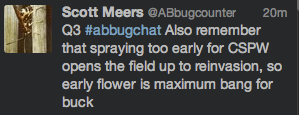Flea beetles are worse that usual in some areas, with growers spraying more than once and with heavy feeding carrying on past the 4-leaf stage. Cutworm losses are low in general but present in some areas. Aster leafhoppers are at much lower numbers than last year and the aster yellows threat is minimal based on what we know at this stage. Cabbage seedpod weevil numbers are picking up and some southern Alberta and southwestern Saskatchewan fields are close to flowering. Early flowering is the control stage for cabbage seedpod weevil adults — as long as they’re at economic thresholds.
Growers who used elemental sulphur for their sulphur source this spring may need to top dress. Elemental sulphur will not address sulphur needs in the year of application. Keep an eye out for signs of sulphur deficiency in the bolt to bud stage.
A possible answer for fields too wet for the sprayer: Aerial. Given the negative economics of late herbicide spraying on canola (see last week’s article), growers do have aerial options if weeds are getting away on them and the window is closing.
Sclerotinia stem rot risk increases with rain. Moist soils during the two weeks before canola flowering begins will increase sclerotia germination in the soil, and increase the number of apothecia shooting spores into the canopy. Any rain at flowering will put canola growers at the same risk as last year, and last year was a heavy year for sclerotinia stem rot. Spores will be everywhere.
Twitter is a valuable source of agronomy information from @CanolaWatch, the CCC’s Crop Production team and many others. Here’s a Tweet on cabbage seedpod weevil management from this week’s #ABbugchat:

